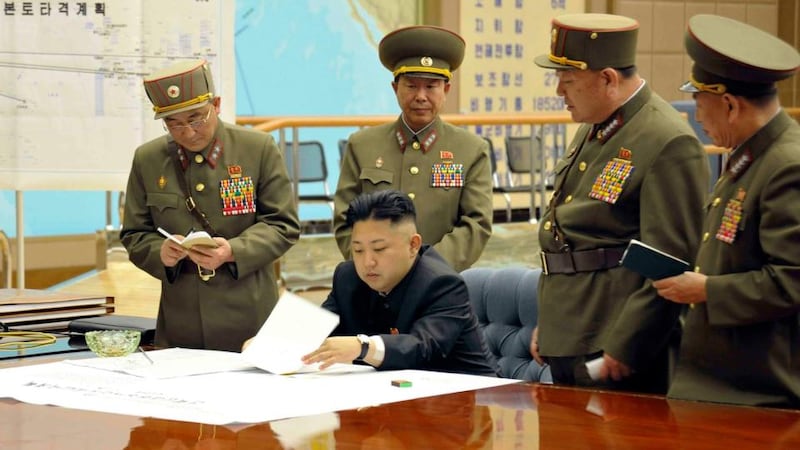North Korea pledged today to restart a nuclear reactor which can make one bomb's worth of plutonium a year, escalating tensions already raised by near daily warlike threats against the United States and South Korea.
The North’s plutonium reactor was shut down in 2007 as part of international nuclear disarmament talks which have since stalled. The declaration of a resumption of plutonium production — the most common fuel in nuclear weapons — and other facilities at the main Nyongbyon nuclear complex will boost fears in Washington and among its allies about North Korea’s timetable for building a nuclear-tipped missile that can reach the US, technology it is not currently believed to have.
A spokesman for the North’s General Department of Atomic Energy said scientists will begin work at a uranium enrichment plant and a graphite-moderated 5 megawatt reactor, which generates spent fuel rods laced with plutonium and is the core of the Nyongbyon nuclear complex.

The unidentified spokesman said the measure is part of efforts to resolve the country’s acute electricity shortage but also for “bolstering up the nuclear armed force both in quality and quantity,” according to a statement carried by the official Korean Central News Agency.
Pyongyang conducted its third nuclear test in February, prompting a new round of UN sanctions which have infuriated its leaders and led to a torrent of threatening rhetoric. The US has sent nuclear-capable bombers and stealth jets to participate in annual South Korean-US military drills that the allies call routine but that Pyongyang claims are invasion preparations.
North Korea has declared that the armistice ending the Korean War in 1953 is void, threatened to launch nuclear and rocket strikes on the US and, most recently, declared at a high-level government assembly that making nuclear arms and a stronger economy are the nation’s top priorities.
The threats are seen as efforts to force policy changes in Seoul and Washington and increase domestic loyalty to young North Korean leader Kim Jong Un by portraying him as a powerful military force.
“North Korea is keeping tension and crisis alive to raise stakes ahead of possible future talks with the United States,” said Hwang Jihwan, a North Korea expert at the University of Seoul.
“North Korea is asking the world ‘What are you going to do about this?”’ North Korea added the 5-megawatt, graphite-moderated reactor to its nuclear complex at Nyongbyon in 1986 after seven years of construction.
The country began building a 50-megawatt and a 200- megawatt reactor in 1984, but construction was suspended under a 1994 nuclear deal with Washington.
North Korea says the facility is aimed at generating electricity. It takes about 8,000 fuel rods to run the reactor. Reprocessing the spent fuel rods after a year of reactor operation could yield about 7 kilograms of plutonium — enough to make at least one nuclear bomb, experts say. Nuclear bombs can be produced with highly enriched uranium or with plutonium.
North Korea is believed to have exploded plutonium devices in its first two nuclear tests, in 2006 and 2009.
In 2010, the North unveiled a long-suspected uranium enrichment programme, which would give it another potential route to make bomb fuel. Uranium worries outsiders because the technology needed to make highly enriched uranium bombs is much easier to hide than huge plutonium facilities.
But experts say plutonium is considered better for building small warheads, which North Korea needs if it is going to put them on missiles. Analysts say they do not believe North Korea currently has mastered such miniaturisation technology.
Scientist and nuclear expert Siegfried Hecker has estimated that Pyongyang has 24 to 42 kilograms of plutonium - enough for perhaps four to eight rudimentary bombs similar to the plutonium weapon used on Nagasaki in the Second World War. It is not known whether the North’s latest atomic test, in February, used highly enriched uranium or plutonium stockpiles. South Korea and other countries have so far failed to detect radioactive elements that may have leaked from the test and which could determine what kind of device was used.
“North Korea is dispelling any remaining uncertainties about its intention for developing nuclear arms. It is making it clear that its nuclear arms programme is the essence of its national security and that it’s not negotiable,” said Sohn Yong-woo, a professor at the Graduate School of National Defense Strategy of Hannam University in South Korea.
“North Korea is more confident about itself than ever after the third nuclear test,” Prof Sohn said. “That confidence is driving the leadership toward more aggressive nuclear development.”
Reuters










